height AUDI A5 CABRIOLET 2013 Owners Manual
[x] Cancel search | Manufacturer: AUDI, Model Year: 2013, Model line: A5 CABRIOLET, Model: AUDI A5 CABRIOLET 2013Pages: 290, PDF Size: 72.35 MB
Page 63 of 290
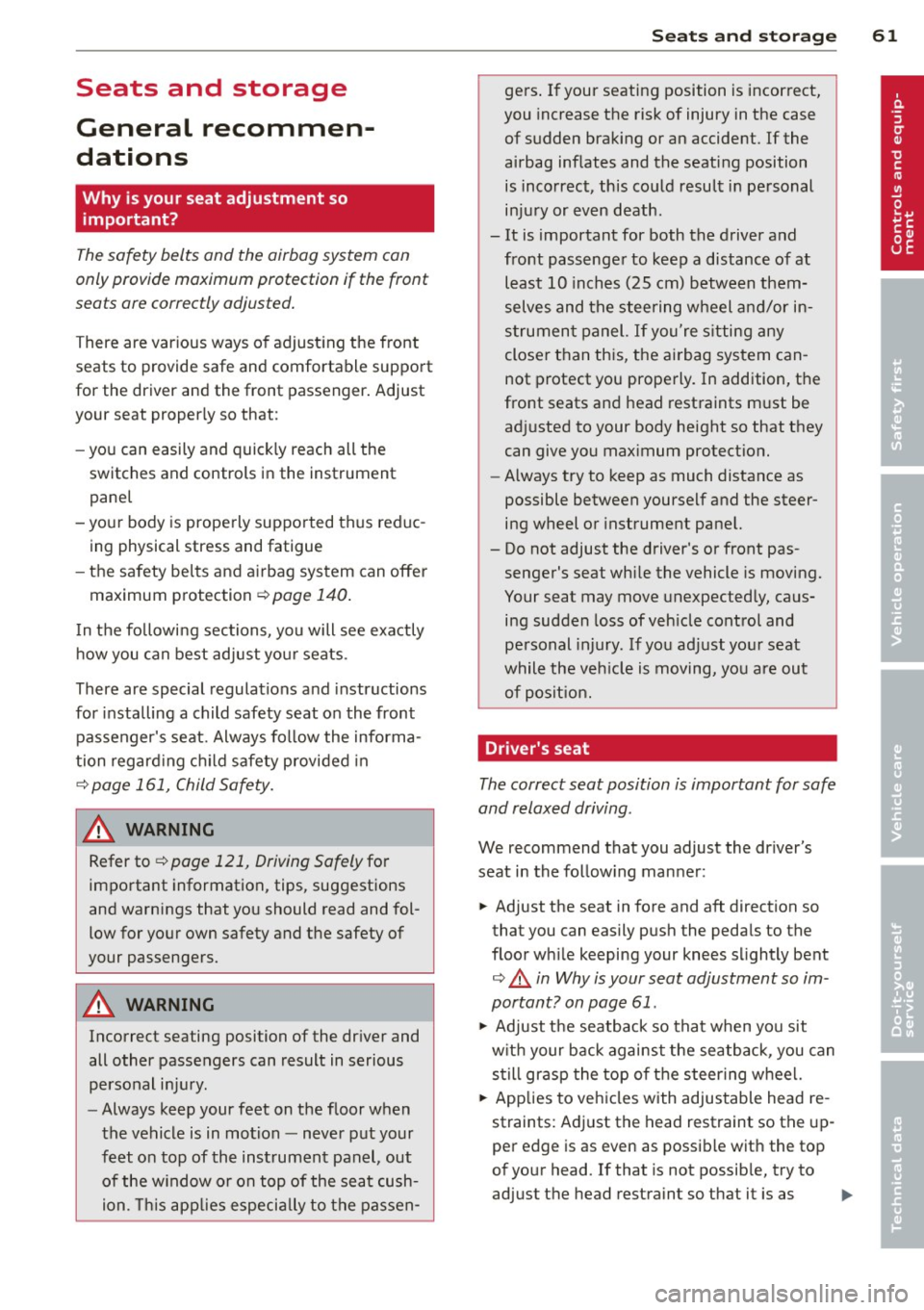
Seats and storage
General recommen
dations
Why is your seat adjustment so important?
The safety belts and the airbag system can
only provide maximum protection if the front
seats are correctly adjusted.
There are various ways of adjusting the front
seats to provide safe and comfortable support
for the driver and the front passenger. Adjust
your seat properly so that :
- you can easily and quick ly reach all the
switches and controls in the instrument
panel
- your body is properly supported thus reduc ing physical stress and fatigue
- the safety belts and airbag system can offe r
maximum protection
¢ page 140.
I n the following sections, you will see exactly
how you can best adjust your seats .
There are special regulations and instructions
for installing a child safety seat on the front passenger's seat. Always follow the informa
tion regard ing child safety provided in
¢ page 161, Child Safety.
.&_ WARNING
-
Refer to ¢ page 121, Driving Safely for
important information, tips, suggestions
and warnings that you should read and fol
low for your own safety and the safety of
your passengers.
.&_ WARNING
Incorrect seating position of the driver and
all other passengers can result in serious
personal injury.
- Always keep your feet on the floor when
the vehicle is in motion -never put your
feet on top of the instrument panel, out of the w indow or on top of the seat cush
ion. This app lies especially to the passen-
S eat s an d sto rage 61
gers . If your seating position is incorrect,
you increase the risk of injury in the case
of sudden braking or an accident . If the
airbag inflates and the seating position
is incorrect, this cou ld result in pe rsonal
in jury or even death.
- It is important for both the driver and front passenger to keep a distance of at least 10 inches (25 cm) between them
selves and the steering wheel and/or in
s trumen t panel. If you're s itting any
closer than th is, the airbag system can
not protect you properly. In addition, the
front seats and head restraints m ust be
adj usted to your body height so that they
can give you max imum protect ion.
- Always try to keep as much distance as
possible between yourself and the steer
ing wheel or instrument panel.
- Do not adjust the driver's or front pas senger's seat whi le the vehicle is moving.
Your seat may move unexpectedly, caus
ing sudden loss of veh icle control and
pe rsonal injury. If you adjust you r seat
while the veh icle is moving, you are ou t
of po sit ion.
Driver's seat
The correct seat position is important for safe
and relaxed driving .
We recommend that you adjust the dr iver's
seat in the follow ing manner:
.., Adjust the seat in fore and aft direction so
that you can easily push the pedals to the
floor wh ile keeping your knees slightly bent
¢ .&, in Why is your seat adjustment so im
portant? on page 61 .
"" Adjust the seatback so that when you sit
w ith your back against the seatback , you can
s ti ll grasp the top of t he steering wheel.
... App lies to vehicles with adjustable head re
straints: Adjust the head restraint so the up
per edge is as even as possible wit h the top
of your head. If that is not possib le, try to
adjust the head restraint so that it is as .,.
Page 64 of 290
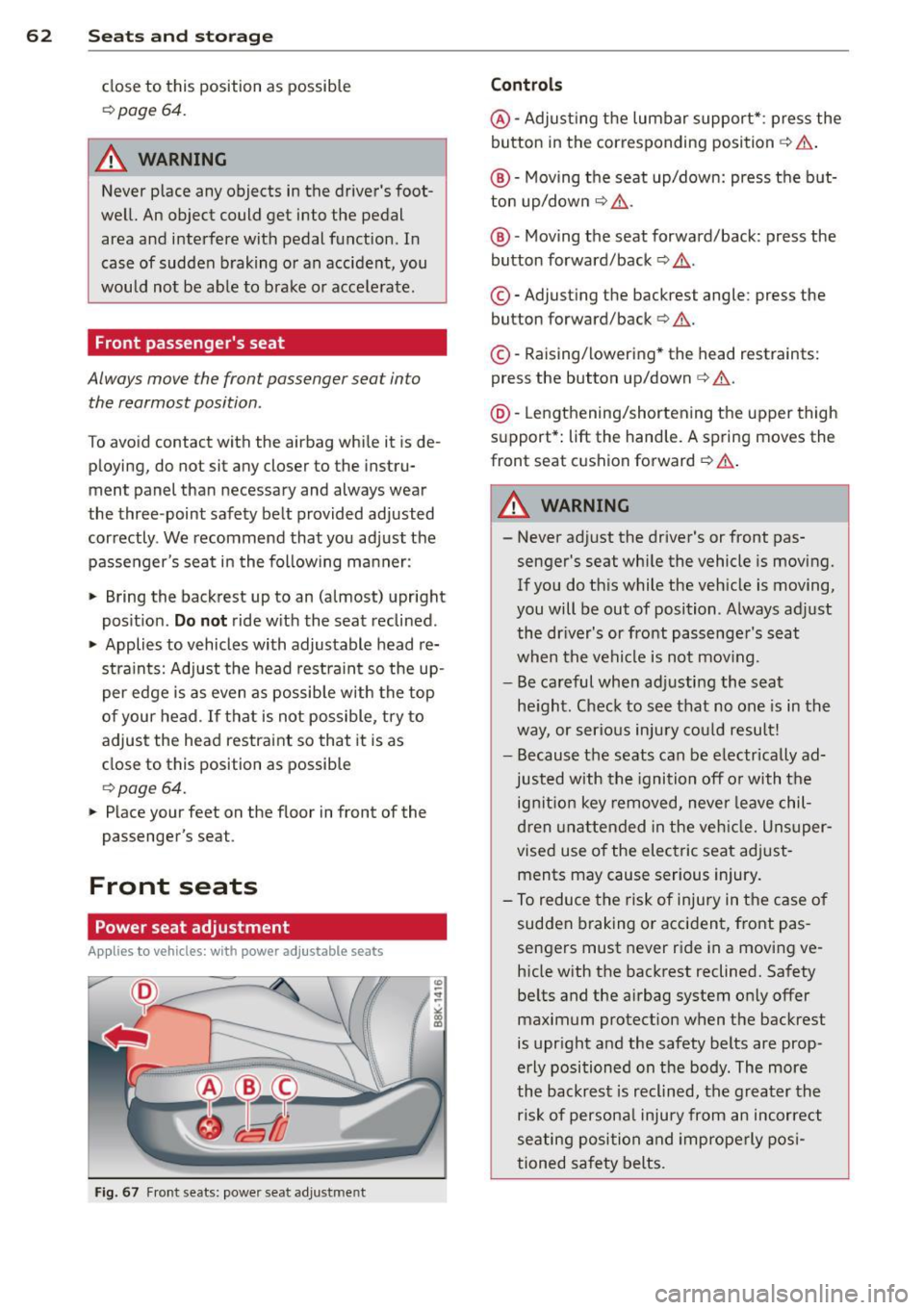
62 Seats and storage
close to this position as possible
¢page 64.
A WARNING
Never place any objects in the driver's foot
well. An object could get into the pedal area and interfere with pedal function. In
case of sudden braking or an accident, you
would not be able to brake or accelerate .
Front passenger's seat
Always move the front passenger seat into
the rearmost position.
To avoid contact with the airbag while it is de
ploying, do not sit any closer to the instru
ment panel than necessary and always wear
the three-point safety belt provided adjusted correctly . We recommend that you adjust the
passenger's seat in the following manner:
• Bring the backrest up to an (almost) upright
position. Do not ride with the seat reclined.
• Applies to vehicles with adjustable head re
straints: Adjust the head restraint so the up
per edge is as even as possible with the top
of your head. If that is not possible, try to
adjust the head restraint so that it is as
close to this position as possible
¢ page 64.
• Place your feet on the floor in front of the
passenger's seat.
Front seats
Power seat adjustment
Applies to vehicles: with power adjustab le seats
Fig. 67 Front seats: power seat adjustment
Controls
@-Adjusting the lumbar support* : press the
button in the corresponding position ¢ .&, .
@ -Moving the seat up/down: press the but
ton up/down ¢ .&, .
@ -Moving the seat forward/back: press the
button forward/back¢ .&,.
©-Adjusting the backrest angle: press the
button forward/back¢ .&..
©-Raising/lowering * the head restraints:
press the button up/down¢.&. .
@ -Lengthening/shortening the upper thigh
support* : lift the handle. A spring moves the
front seat cushion forward ¢ .&. .
A WARNING
---Never adjust the driver's or front pas
senger's seat while the vehicle is moving.
If you do this while the vehicle is moving,
you will be out of position . Always adjust
the driver's or front passenger's seat
when the vehicle is not mov ing.
- Be careful when adjusting the seat
height. Check to see that no one is in the
way, or serious injury could result!
- Because the seats can be electrically ad
justed with the ignition off or with the
ignition key removed, never leave chil
dren unattended in the vehicle. Unsuper
vised use of the electric seat adjust
ments may cause serious injury.
- To reduce the risk of injury in the case of
sudden braking or accident, front pas
sengers must never ride in a moving ve
hicle with the backrest reclined. Safety
belts and the airbag system only offer maximum protection when the backrest
is upright and the safety belts are prop
erly positioned on the body. The more
the backrest is reclined, the greater the
risk of personal injury from an incorrect
seating position and improperly posi
tioned safety belts.
Page 66 of 290

64 Seats and storage
Center armrest
The center armrest can be adjusted to several
levels.
Fig. 70 Armrest between the driver's/front passenger's
seats .
Adjusting the center armrest
.. To adjust the angle, raise the armrest from
t he starting position
¢ fig. 70 detent by de
tent.
" To bring the armrest back into the starting
position, raise it out of the top detent and
fold it back down .
The armrest can slide forward and back .
Head restraints
Front head restraints
Applies to vehicles: with a djustable head restrain ts
Head restraints that are adjusted according
to body size, along with the seat belt , offer
effective protection.
Fig. 71 Fro nt seat: adjusting the manual head re
st raint s
Fig. 72 Front seat: ad just ing the power head restraint
Adjust the head restraint so the upper edge is
as even as possible with the top of your head.
If that is not possible, try to adjust the head
restraint so that it is as close to this position
as possible
¢ page 64 .
.,. To adjust the height of the manual head re
straint*, grip the head restraint on the sides
with both hands and slide it up/down until it
locks into p lace
¢fig. 71.
"' To adjust the height of the power head re
straint*, press the button up/down
¢ fig. 72.
Refer to¢ page 124, Proper adjustment of
head restraints
for guidelines on how to ad
just the height of the front head restraints to suit the occupant's body size.
A WARNING
- Driving without head restraints or with
head restraints that are not properly ad
justed increases the risk of serious or fa
tal neck injury dramatically.
- Read and heed all WARNINGS
¢page 124 ,
@ Tips
Correctly adjusted head restraints and
safety belts are an extremely effective
combination of safety features .
Seat memory
Description
Applies to vehicles : wi th memo ry fun ctio n
The memory function allows you to quickly
and easily store and recall personal seating
Page 123 of 290
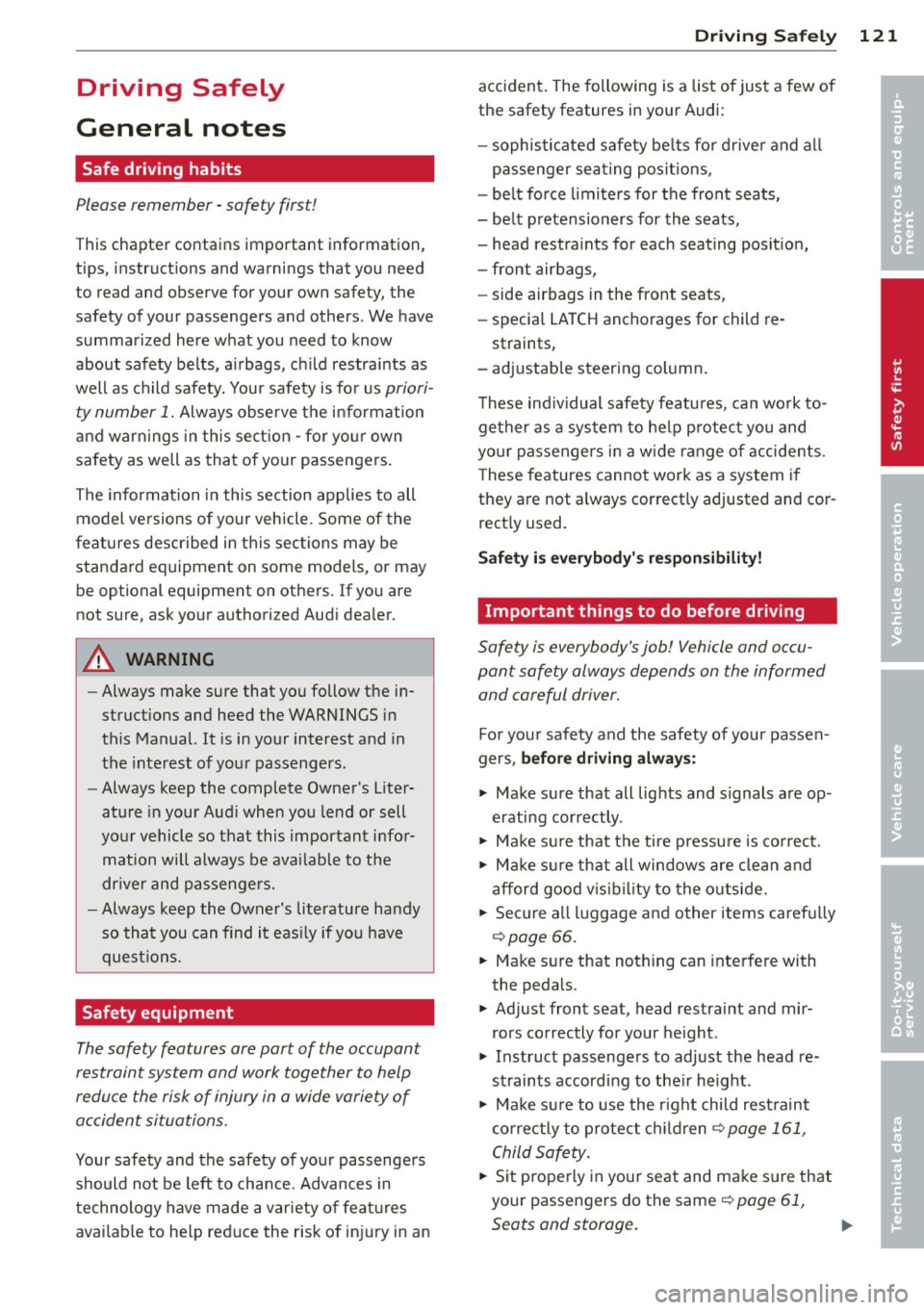
Driving Safely
General notes
Safe driving habits
Please remember -safety first!
This chapter contains important information,
tips, instructions and warnings that you need
to read and observe for your own safety, the
safety of your passengers and others . We have
summarized here what you need to know
about safety belts, airbags, child restraints as
well as child safety. Your safety is for us
priori
ty number 1.
Always observe the information
and warnings in this section - for your own
safety as well as that of your passengers.
The information in this section applies to all
model versions of your vehicle . Some of the
features described in this sections may be
standard equipment on some models, or may
be optional equipment on others. If you are
not sure, ask your authorized Audi dealer.
A WARNING
-Always make sure that you follow the in
structions and heed the WARNINGS in
this Manual. It is in your interest and in
the interest of your passengers.
- Always keep the complete Owner's Liter
ature in your Audi when you lend or sell
your vehicle so that this important infor
mation will always be available to the
driver and passengers.
- Always keep the Owner's literature handy
so that you can find it easily if you have
questions.
Safety equipment
The safety features are part of the occupant
restraint system and work together to help
reduce the risk of injury in a wide variety of
accident situations .
Your safety and the safety of your passengers
should not be left to chance. Advances in
technology have made a variety of features
available to help reduce the risk of injury in an
Driving Safely 121
accident. The following is a list of just a few of
the safety features in your Audi :
- sophisticated safety belts for driver and all
passenger seating positions,
- belt force limiters for the front seats,
- belt pretensioners for the seats,
- head restraints for each seating position,
- front airbags,
- side airbags in the front seats,
- special LATCH anchorages for child re-
straints,
- adjustable steering column.
These individual safety features, can work to
gether as a system to help protect you and
your passengers in a wide range of accidents.
These features cannot work as a system if
they are not always correctly adjusted and cor
rectly used.
Safety is everybody's responsibility!
Important things to do before driving
Safety is everybody's job! Vehide and occv
pant safety always depends on the informed
and careful driver.
For your safety and the safety of your passen
gers,
before driving always:
.,. Make sure that all lights and signals are op
erating correctly .
"' Make sure that the tire pressure is correct.
.,. Make sure that all windows are clean and
afford good visibility to the outside.
.,. Secure all luggage and other items carefully
r=)page 66.
.,. Make sur e that nothing can interf ere with
the pedals .
.,. Adjust front seat, head restraint and mir
rors correctly for your height.
.,. Instruct passengers to adjust the head re
straints according to their height .
"' Make sure to use the right child restraint
correctly to protect children
r=) page 161,
Child Safety.
.,. Sit properly in your seat and make sure that
your passengers do the same
r=) page 61,
Seats and storage.
ll>
•
•
Page 139 of 290
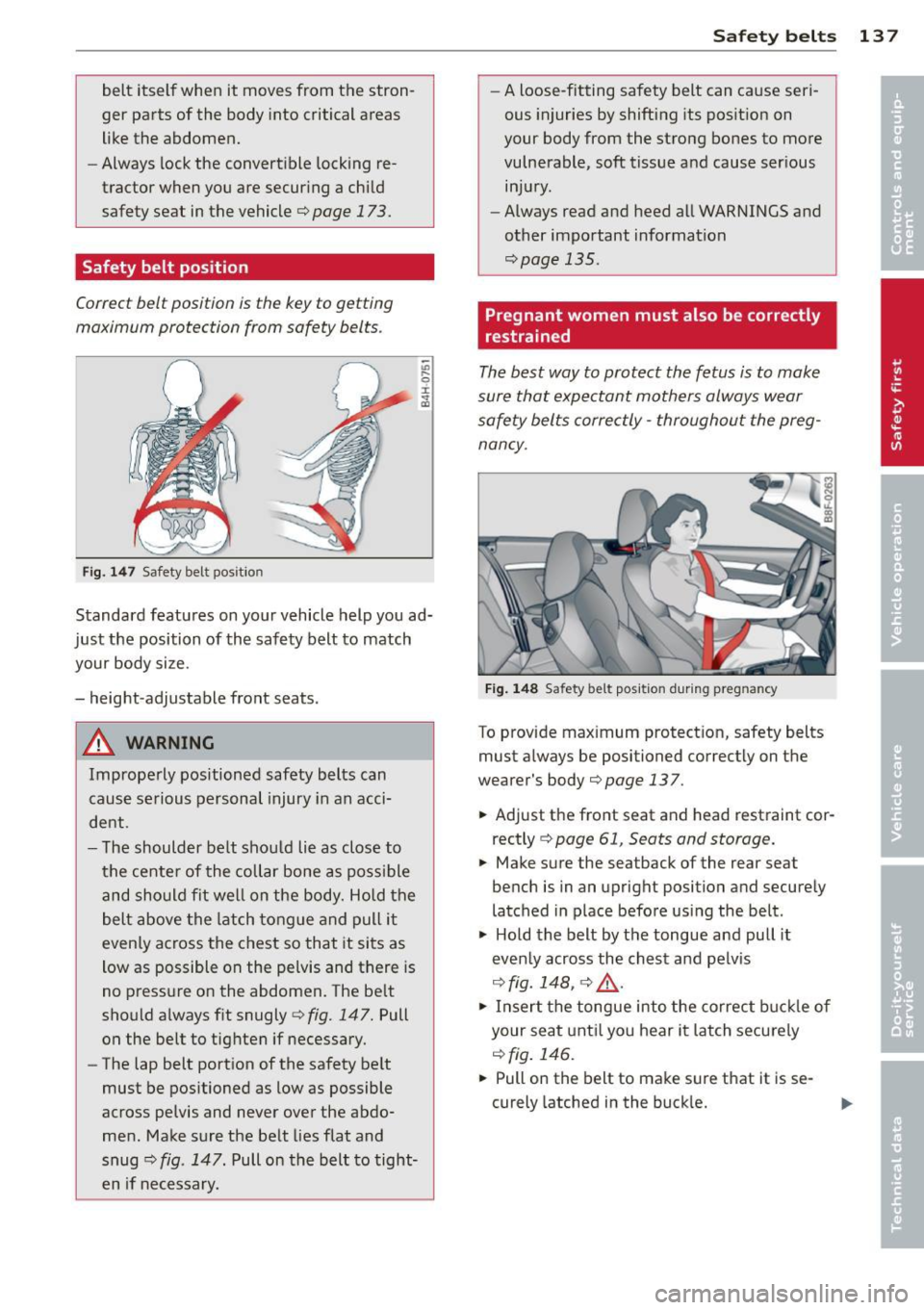
belt itself when it moves from the stron
ger parts of the body into critical areas
like the abdomen.
- Always lock the convertible locking re
tractor when you are securing a child safety seat in the vehicle ¢
page 173.
Safety belt position
Correct belt position is the key to getting
maximum protection from safety belts .
Fig. 147 Safety belt pos it io n
"' ,-. 0 ±
just the position of the safety belt to match your body size .
- height -adjustable front seats.
A WARNING
Improperly positioned safety belts can
cause serious personal injury in an acci
dent .
- The shoulder belt should lie as close to
the center of the collar bone as possible
and should fit well on the body. Hold the
belt above the latch tongue and pull it
evenly across the chest so that it sits as
low as possible on the pelvis and there is
no pressure on the abdomen. The belt
should always fit snugly
¢ fig. 147. Pull
on the belt to tighten if necessary.
- The lap belt portion of the safety belt
must be positioned as Low as possible
across pelvis and never over the abdo
men. Make sure the belt lies flat and
snug
¢ fig . 147 . Pull on the belt to tight
en if necessary.
Safety belts 13 7
-A loose-fitting safety belt can cause seri
ous injuries by shifting its position on
your body from the strong bones to more
vulnerable, soft tissue and cause serious injury.
- Always read and heed all WARNINGS and
other important information
¢page 135.
Pregnant women must also be correctly
restrained
The best way to protect the fetus is to make
sure that expectant mothers always wear
safety belts correctly -throughout the preg
nancy.
Fig. 148 Safety bel t position during pregnancy
To provide maximum protect ion, safety belts
must always be positioned correctly on the
wearer's body¢
page 13 7.
.,. Adjust the front seat and head restraint cor
rectly ¢
page 61 , Seats and storage.
.,. Make sure the seatback of the rear seat
bench is in an upright position and securely
latched in place before using the belt .
.,. Hold the belt by the tongue and pull it
evenly across the chest and pelvis
¢ fig. 148, ¢ &_.
.,. Insert the tongue into the correct buckle of
your seat until you hear it latch securely
¢fig. 146.
.,. Pull on the belt to make sure that it is se
curely latched in the buckle.
Page 157 of 290

dealer is familiar with these requirements
and we recommend that you have your
dealer perform this service for you.
Other things that can affect Advanced
Airbag performance
Changing the vehicle's suspension system can
change the way that the Advanced Airbag Sys
tem performs in a crash. For example, using
tire-r im combinations not approved by Audi,
lowering the vehicle, changing the stiffness of
the suspension, including the springs, suspen
sion struts, shock absorbers etc. can change
the forces that are measured by the airbag sensors and sent to the electronic control
unit. Some suspension changes can, for exam
ple, increase the force levels measured by the
sensors and make the airbag system deploy in
crashes in which it would not deploy if the
changes had not been made . Other kinds of
changes may reduce the force levels meas
ured by the sensors and prevent the airbag
from deploying when it should .
The sensors in the safety belt buckle for the
d river and front passenger seat tell the elec
tronic control module if the safety belt is
latched or not. If the safety belt is being used,
the front airbag will deploy at a slightly high
er rate of vehicle deceleration than if the safe
ty belt is not being used. Therefore, in a par
ticular collision, it is possible that an airbag
will not deploy at a seating position where the safety belt is being used but will inflate at the
position where the safety belt is not being
used. It is important that nothing interfere
with the safety belt buckles so that the sen
sors can send the correct information about
safety belt use to the electronic control unit.
.&_ WARNING
Changing the vehicle 's suspension includ
ing use of unapproved tire-rim combina
tions can change Advanced Airbag per
formance and increase the risk of serious personal injury in a crash.
- Never install suspension components
that do not have the same performance
Airbag system 155
characteristics as the components origi
nally installed on your vehicle .
- Never use tire-rim combinations that
have not been approved by Audi.
.&_ WARNING
= -
Items stored between the safety belt buckle and the center console can cause
the sensors in the buckle to send the
wrong information to the electronic con
trol module and prevent the Advanced Air bag System from working properly.
-Always make sure that nothing can inter-
fere with the safety belt buckles and that
they are not obstructed.
Knee airbags
Description of knee airbags
Applies to vehicles: wit h knee airbags
The knee airbag system can provide supple
mental protection to properly restrained
front seat occupants.
Fig. 154 Driver 's knee airbag
The driver knee airbag is in the instrument
panel underneath the steering wheel
Q fig . 154, the knee airbag for the passenger
is at about the same height in the instrument
panel underneath the glove compartment .
The knee airbag offers additional protection
to the driver's and passenger's knees and up
per and lower thigh areas and supplements
the protection provided by the safety belts.
If the front airbags deploy, the knee airbags
also deploy in frontal collisions when the de ployment threshold stored in the control unit
I),-
Page 240 of 290
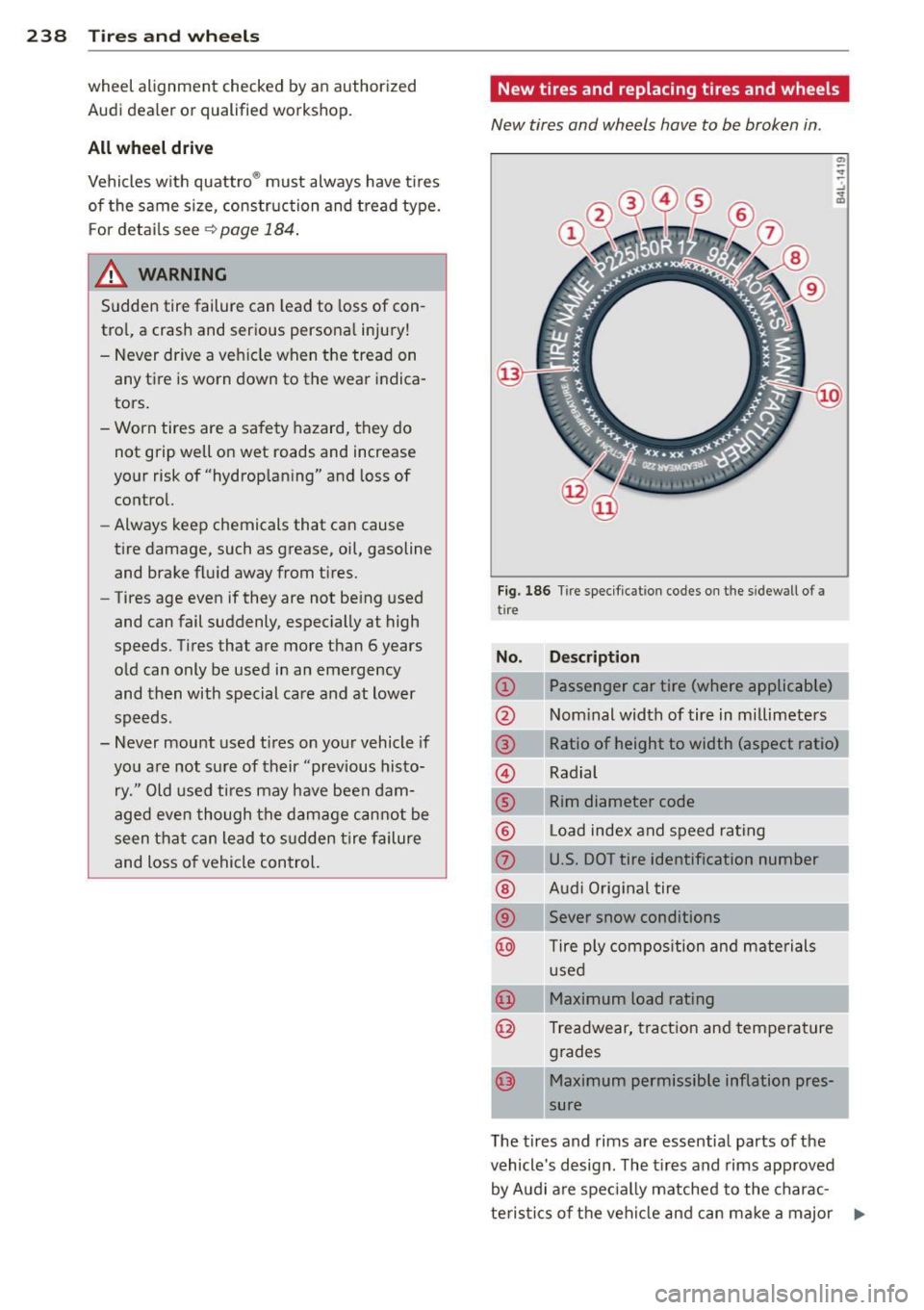
238 Tires and w hee ls
wheel alignment checked by an authorized
Audi dealer or qualified workshop.
All wheel dri ve
Vehicles w ith quattro ® must always have tires
of the same size, construction and tread type. F or detai ls see
¢ page 184 .
.8, WARNING
Sudden tire failure can lead to loss of con
trol, a crash and serious personal injury!
- Never drive a veh icle when the tread on
any tire is worn down to the wear indica
tors.
- Worn tires are a safety hazard, they do not grip well on wet roads and increase
your risk of "hydrop lan ing" and loss of
control.
- Always keep chemicals that can cause
tire damage, such as grease, oil, gasoline
and brake fluid away from tires.
- Tires age even if they are not being used
and can fail suddenly, especially at high
speeds. Tires that are more than 6 years
old can only be used in an emergency
and then with special care and at lower
speeds.
- Never mount used tires on your vehicle if
you are not sure of their "previous histo
ry." Old used tires may have been dam
aged even though the damage cannot be
seen that can lead to s udden tire failure
and loss of vehicle control.
New tires and replacing tires and wheels
New tires and wheels have to be broken in .
Fig. 186 Tir e specificat ion c odes on t he s idewall o f a
t ire
N o. Descri ption
(!) Passenger car tire (where applicable)
@ Nom inal width of tire in millimeters
@ Ratio of height to width (aspect ratio)
© Radial
® Rim diameter code
@ L oad index and speed rating
(J) U.S. DOT tire identification number
@ Audi Orig inal tire
@ Sever snow conditions
@ Tire ply compos ition and mate rials
used
Maximum load rating
Treadwear, traction and temperature
grades
Maximum permissible inflation pres
sure
T he t ires and rims are essential parts of the
vehicle 's design . The tires and rims approved
by Audi are spec ially matched to the charac
teristics of the vehicle and can make a major .,..
Page 241 of 290
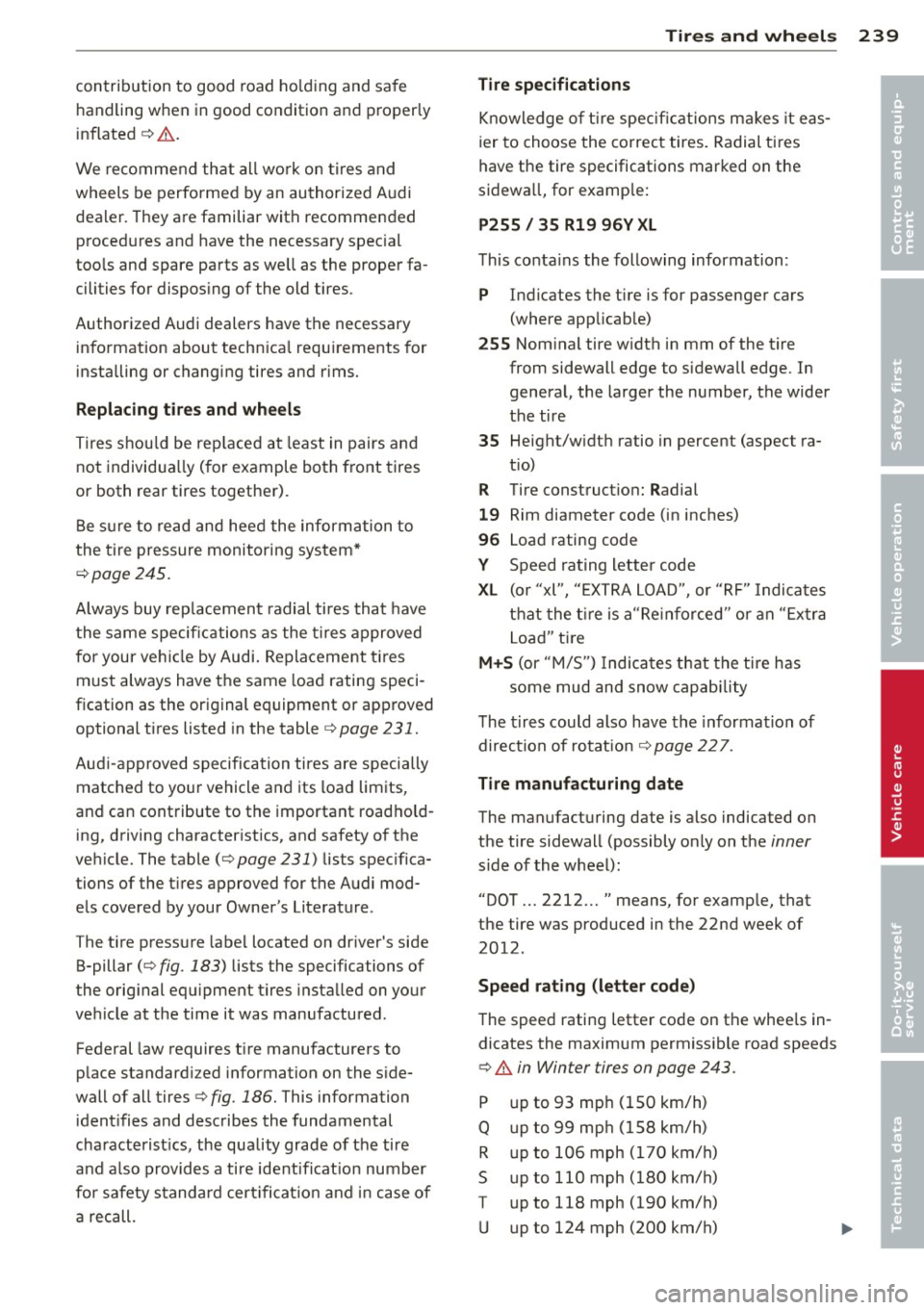
contribution to good road holding and safe
handling when in good condition and properly
inflated
¢ .&. .
We recommend that all work on t ires and
wheels be performed by an authorized A udi
dealer. They are familiar with recommended
procedures and have the necessary spec ial
too ls and spare parts as we ll as the proper fa
cilities for dispos ing of the old tires .
Authorized Audi dealers have the necessary information about techn ica l requ irements for
installing or changing tires and r ims.
R eplacing t ires and wheel s
Tires shou ld be rep laced at least in pairs and
not individua lly (for example both front tires
or both rear tires together).
Be s ure to read and heed the information to
the tire pressure monitoring system*
¢ page 245.
Always buy rep lacement radial tires that have
the same specifications as the t ires approved
for your ve hicle by Audi. Replacement tires
must always have the same load rating speci
fication as the original equipment or approved
optional tires listed in the table¢
page 231.
Audi-approved specification tires are specially
matched to your vehicle and its load limits ,
and can contribute to the important road hold
ing, driving character istics, and safety of the
veh icle. The table
( ¢ page 231) lists spec ifica
tions o f the t ires approved for the Audi mod
e ls covered by your Owner 's Literature .
T he tire pressure labe l located on dr iver 's side
B-pillar
( ¢ fig . 183) lists the specifications of
the orig inal equ ipment tires insta lled on your
ve hicle at the time it was manufactured .
Federal law requires tire manufacturers to
place standa rd iz ed information on the s ide
wall of all tires¢
fig. 186. This information
ident ifies and describes the fundamental
characterist ics, the quality grade of the tire
and a lso provides a tire identificat ion number
for safety standard certificat ion and i n case of
a recall. Tire
s an d wheel s 239
Tire specification s
Knowledge of tire specifications makes it eas
i er to choose the co rrect tires . Radial tires
have the tire specifications marked on the
sidewa ll, for examp le:
P255 / 35 Rl9 96V XL
This conta ins the following information :
P Indicates the tire is for passenger cars
(where applicab le)
2 55 Nom inal ti re w idth in mm of the tire
from sidewall edge to sidewall edge. In general , the larger the number, the wider
the tire
35 Height/w idt h ratio in percent (aspect ra-
t io)
R Tire construct ion: Radial
19 Rim diameter code (in inches)
96 Load rating code
Y Speed rating letter code
XL (or "xl", "E XTRA LOAD", or "RF" Indicates
that the t ire is a"Re in forced" or an "Ex tra
Load" t ire
M+S (or "M/S") Indica tes that the tire has
some mud and snow capability
The tires could also have the informat ion of
direction of rotat ion
¢ page 22 7 .
Tire manuf acturing d ate
The manufacturing date is also indicated on
the tire sidewall (possibly on ly on the
inner
s ide of the wheel):
"DOT ... 2212 ... "means, for examp le, that
the tire was produced in the 22nd week of 2012 .
Speed rating (letter c ode)
The speed rating letter code on the whee ls in
dicates the maximum permiss ible road speeds
¢ .&. in Winter tires on page 243 .
P up to 93 mph (1S0 km/h)
Q up to 99 mp h (158 km/h)
R up to 106 mph ( 170 km/h)
S up to 110 mph ( 180 km/h)
T up to 118 mph (190 km/h)
U up to 124 mph (200 km/h)
•
•
Page 246 of 290
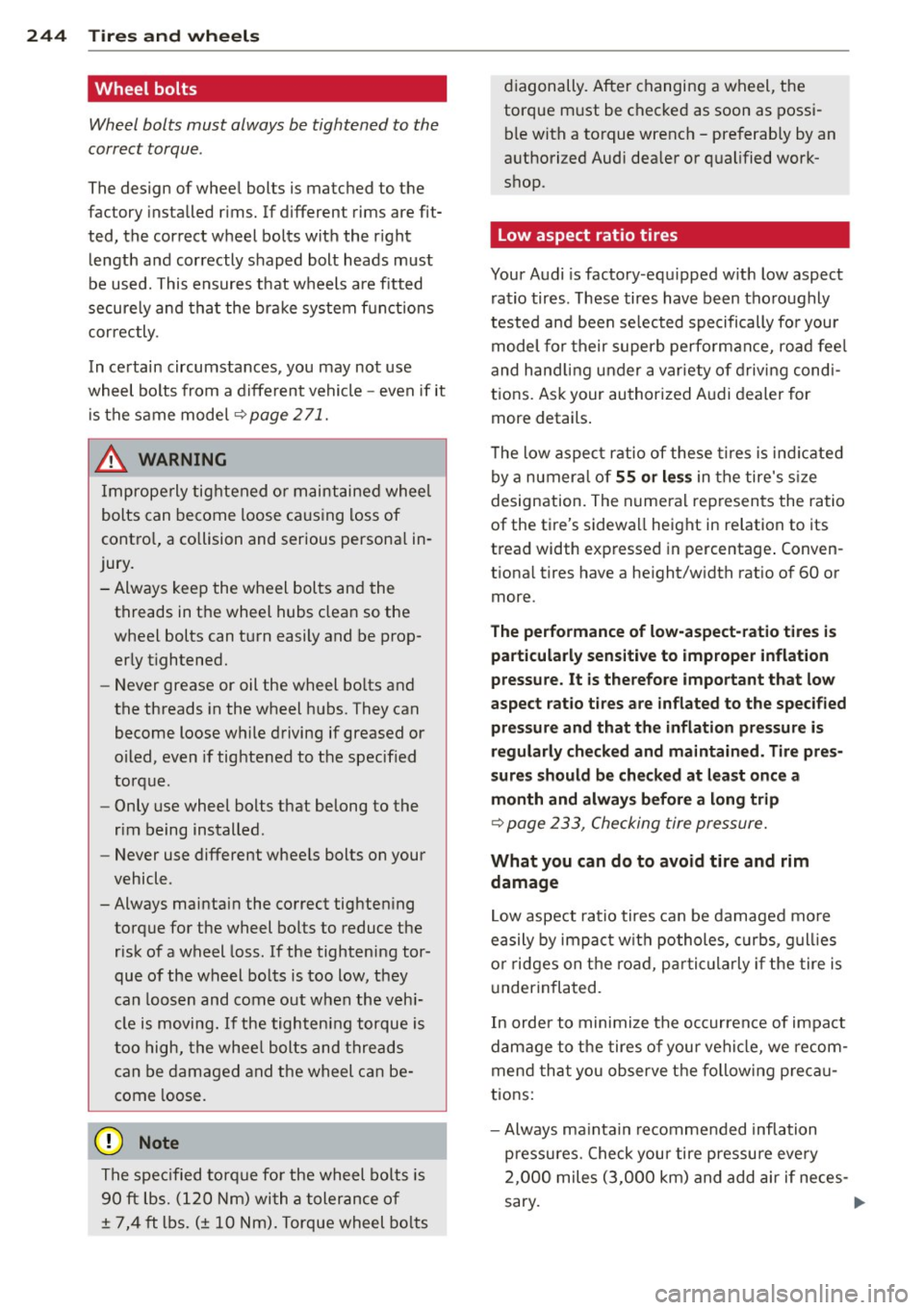
24 4 T ire s and wheel s
Wheel bolts
Wheel bolts must always be tightened to the
correct torque .
The design of wheel bolts is matched to the
factory installed rims. If differen t rims are fit
ted, the correct wheel bolts with the r ight
length and correctly shaped bolt heads must
be used. This ensures that wheels are fitted
secure ly and that the brake system funct ions
correctly .
In ce rtain circumstances, you may not use
wheel bolts from a different vehicle -even if it
i s the same model~
page 2 71.
_& WARNING
Improperly tig htened o r maintained whee l
bolts can become loose ca using loss of
contro l, a co llision and serious persona l in
jury.
- Always keep the wheel bolts and the
threads in the wheel hubs clean so the
wheel bolts can turn easily and be prop
erly t ightened.
- Never grease or oil the wheel bo lts and
the threads in the wheel hubs. They can
become loose while driving if greased or
oiled, even if tightened to the specif ied
torque .
- Only use wheel bolts that belong to the
rim being installed .
- Never use different wheels bolts on your
vehicle .
-Always maintain the correct tighten ing
torque for the wheel bo lts to reduce the
risk of a wheel loss. If the tightening tor
que of the wheel bolts is too low, they
can loosen and com e out when the veh i
cl e is moving. If the tightening torque is
too high, the whee l bolts and threads
can be damaged and the wheel can be
come loose.
@ Note
The spec ified torq ue fo r the wheel bo lts is
90 ft lbs. (120 Nm) wi th a toler ance of
± 7,4 ft lbs. (± 10 Nm). Torque wheel bo lts diagonally. After changing a wheel, the
torque m
ust be checked as soon as possi
ble with a torque wrench -preferably by an
a uthori zed Audi dea ler or q ua lified work
shop .
Low aspect ratio tires
Your Audi is factory -equ ipped w ith low aspect
ratio tires . T hese tires have been thoroughly
tested and been se lected specifically fo r your
model for their superb perfo rmance, road fee l
and hand ling under a variety o f driv ing condi
t ions . As k your authorized A udi dealer for
more details .
T he low aspect ratio of these tires is ind icated
by a numera l of
55 or l ess in the tire's s ize
designation. The numeral represents the ratio
of the tire's sidewa ll height in relation to its
tread width exp ressed in percentage . Conven
tiona l tires have a he ight/w idth ratio of 60 or
more .
The performance of low-a spect-r atio tire s is
pa rt icul arly s ens itive to imp ro per i nfl ation
pressure. It is therefore import ant that low
aspect ratio tires are inflated to the specified pre ssure and that the inflation pressure is
r e gularly checked and maintained . Tire pres
sur es should be checked at l east once a
month and always before a long trip
~ page 233, Checking tire pressure.
What you can do to avoid tire and rim
damage
Low aspect ratio tires can be damaged mo re
easily by impact w it h potholes, c urbs, g ull ies
o r ridges on the road, pa rticul arly if the tire is
u nderinfla ted .
In orde r to minimize the occurrence of impact
damage to t he tires of your vehi cle, we recom
mend tha t you observe the following preca u
tions:
- Always ma inta in recommended inflation
pressu res. Check your tire pressure eve ry
2 ,000 miles (3,000 km) and add air if neces -
sary. ..,.